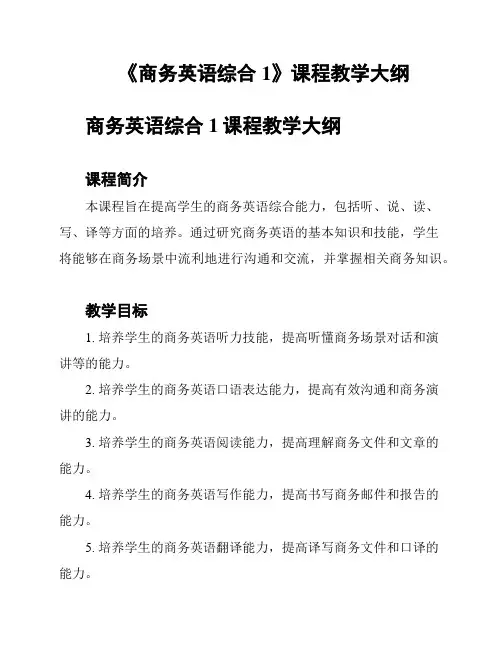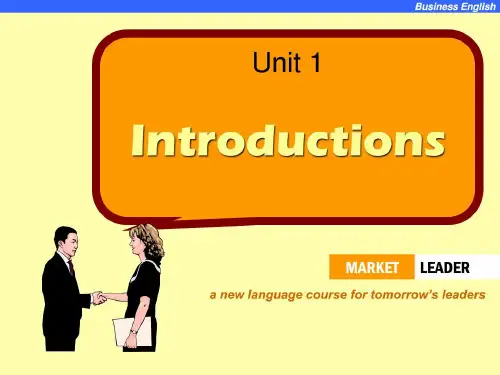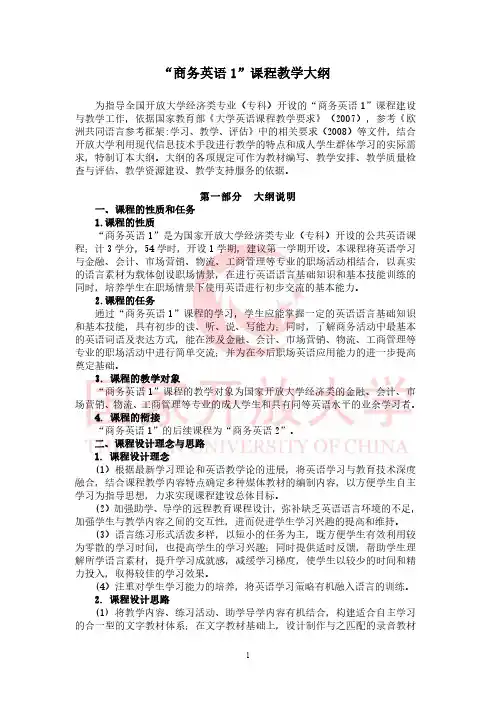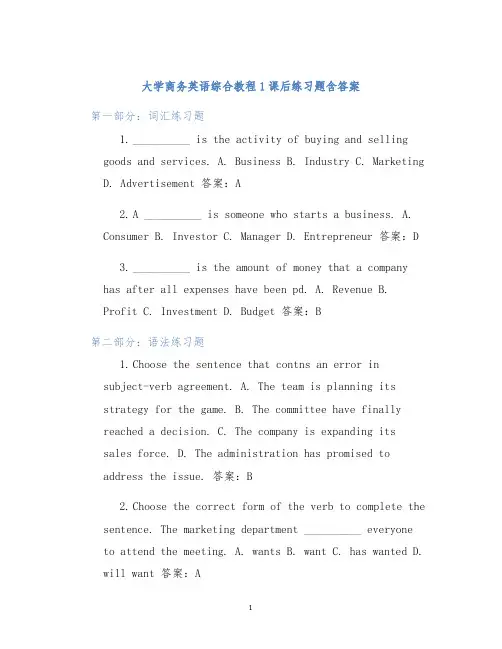综合商务英语第1课
- 格式:ppt
- 大小:1.93 MB
- 文档页数:41

Lesson 1: Essential Job Vocabulary第1课:基本工作词汇Welcome to Lesson 1 of the Business English Course - Essential Job Vocabulary.欢迎学习第1课-基本工作词汇Where do you w ork?你在哪里工作Let's begin by answering the question, "Where do you work?" This seems like a simple question, but there are many ways to answer it:•I work at...•I work in...•I work for...•I work with...You're going to learn when to use each preposition.您将学习何时使用每个介词。
I work at/for... (name of company)我在XX(公司名称)工作/我为XX工作(公司名称)For example, "I work at Espresso English" or "I work for Nike." You can also use "for" if you work directly for a famous person: "I work for Tom Cruise. I'm his public relations manager.”例如,“我在Espresso English工作”或“我为耐克工作”。
如果您直接为一个名人工作,也可以使用“ for”:“我为Tom Cruise工作。
我是他的公共关系经理。
”I work in...我在XX(一个地方)工作...a place:一个地方:•I work in an o ffice. 我在办公室工作。

教案课程名称:___________________________________ 课时:___________________________________ 班级:___________________________________ 任课教师:___________________________________ 教材:_《新视野商务英语综合教程1(第二版)》_Unit 2 Company StructureUnit Overview (单元概览)By studying this unit, students are expected to:●Learn the common types of company structure;●D escribe a company’s structure;●Know how to write an e-mail to introduce a new colleague.Lead-in (主题导入)●Write the word “function” on the board and ask the students how they understandit.●Divide the students into six groups, each discussing the function of one particulardepartment.●Ask each group to give their report on their discussion. Encourage other groups tomake comments.Reading A (精读课文)Task 1●Ask the students to search for related information before class.●In class, ask the students to work in pairs and share their findings.●Invite some volunteers to report their findings in class. Write down the factors asthey report on the board. A class discussion could generate some interestingideas.Task 2●Pre-teach the words in the task which might be difficult for your students.●Ask the students to read through the text and do the task individually.●Check the answers and ask the students to locate the supporting information inthe text.Task 3●Ask the students to answer the questions with the books closed.●Ask the students to read the text again to check their answers.Activity 1●Ask the students to make a list of the advantages and disadvantages of each typeof structure.●Ask the students to share their opinions in pairs and summarize the features ofeach type of structure.●Encourage the students to summarize with their own words. Try to avoidrepeating or reciting sentences from the text.●Choose several pairs to present their ideas to the class.Activity 2●Divide the students into small groups. Each group is to focus on one particularcompany.●Ask the students to divide the online-searching work among group members, forexample:Student A: a brief introduction of the company;Student B and C: structure of the company and its features;Student D and E: factors that may affect the company’s choice of structure.●Ask each group to prepare the introduction by putting together the information.Each group member should have a role in the introduction.PPT or handouts are preferred for the introduction.Focusing on Grammar●动词后缀●被动语态叙述客观事实Reading B (泛读课文)Listening (听力练习)Task 1●Introduce this task by asking the students what they know about theresponsibilities of the departments in the right column. Some of them have been discussed in Lead-in. This pre-listening exercise helps the students predict the information they will hear.●Make sure that the students can pronounce the names properly.●Ask the students to listen to the recording and try to do the match work.●In the second listening, ask the students to write down the keywords describingthe duties of different departments, e.g. recruiting, training, money, payment, cost analysis, etc.●Check the answers with the class. Ask the students to describe the duties of thefive persons in one or two sentences by referring to their notes.●Ask the students to do oral exercises in pairs in a question-and-answer format. Task 2●Give the students some time to read the chart. They can predict some answersbased on the information they’ve got from previous sections.●Pre-teach some words, e.g. welfare, recruitment, compensation, if necessary.●Play the recording a few times so that the students can get enough information tofill in the blanks. They can discuss and work in pairs.●Draw the students’ attention to the phrases describing the duties and the reportingstructure in the recording, e.g. be in charge of, report to, be responsible for, deal with, etc.●Divide the students into several groups. Ask each group to make a list of themembers of the Class Committee and then describe their duties accordingly by using the phrases they’ve learned.●Encourage the students to summarize the information and make it into a shortpresentation.Task 3●Review the features of a divisional structure with the class before they listen.●Ask the students questions like “Can you list the brands in Household Care Unit?To whom will the new employee report?” This makes their listening more focus-based.●Play the recording twice and ask the students to do the task.Communication Project (商务沟通)●Ask each group to choose one member as the note taker.●Ask the students to exchange ideas within the group and ask the note taker towrite down the ideas of the group members.●Invite two or three note takers to report the results of Step 2.●Each group should draw a chart to illustrate the strength of P&G’s structure.●Ask several groups to show their chart and make an introduction to P&Gstructure.●Note that the students can choose some other companies for introduction insteadof P&G.Writing (商务写作)●Ask the students to read Task 1 and discuss how to arrange the contents in an e-mail.●Ask the students to read Task 2 and discuss in pairs how to put the information inTask 1 in the blanks.Moral Reflections (补充教学资源)Unit Overview不以规矩,不能成方圆。

《商务英语综合1》课程教学大纲商务英语综合1课程教学大纲课程简介本课程旨在提高学生的商务英语综合能力,包括听、说、读、写、译等方面的培养。
通过研究商务英语的基本知识和技能,学生将能够在商务场景中流利地进行沟通和交流,并掌握相关商务知识。
教学目标1. 培养学生的商务英语听力技能,提高听懂商务场景对话和演讲等的能力。
2. 培养学生的商务英语口语表达能力,提高有效沟通和商务演讲的能力。
3. 培养学生的商务英语阅读能力,提高理解商务文件和文章的能力。
4. 培养学生的商务英语写作能力,提高书写商务邮件和报告的能力。
5. 培养学生的商务英语翻译能力,提高译写商务文件和口译的能力。
教学内容1. 商务英语听力训练:通过听取商务对话、会议和演讲等,提高学生的听力技能。
2. 商务英语口语表达:研究商务用语、礼貌用语和商务演讲技巧等,提高学生的口语表达能力。
3. 商务英语阅读理解:阅读商务文章、合同和报告等,培养学生理解商务文本的能力。
4. 商务英语写作:研究商务邮件、报告和商务文案的写作技巧,提高学生的书写能力。
5. 商务英语翻译:练商务文件和口译的翻译,提高学生的翻译能力。
教学方法1. 授课讲解:通过讲解商务英语的基本知识和技能,帮助学生理解和掌握。
2. 听力训练:提供商务听力材料,让学生进行听力练和理解。
3. 口语练:组织角色扮演、对话练和商务演讲等活动,提高学生的口语表达能力。
4. 阅读训练:提供商务阅读材料,让学生进行阅读理解练。
5. 写作练:布置商务写作任务,让学生练书写商务邮件和报告。
6. 翻译练:布置商务翻译任务,让学生练商务文件和口译的翻译。
考核方式1. 课堂参与度:学生积极参与课堂讨论和活动的情况。
2. 个人作业:学生完成的听力、口语、阅读、写作和翻译作业情况。
3. 综合测试:对学生综合掌握商务英语能力的考核。
参考教材1. 《商务英语教程》(第一册),李明等编著,外语教学与研究出版社。
2. 《商务英语阅读与写作教程》,张瑞芳编著,外语教学与研究出版社。

高级综合商务英语1课件unit1Unit 1: The Global EconomyIntroduction:In today's interconnected world, understanding the global economy is essential for businesses to thrive. This unit will cover key concepts related to the global economy, including international trade, economic systems, and exchange rates. By gaining a deeper understanding of these topics, students will be better equipped to navigate the complexities of the global marketplace.Key Concepts:1. International Trade:International trade plays a crucial role in the global economy, enabling countries to exchange goods and services across borders. In this section, students will learn about the benefits of international trade, including increased economic growth, market access, and specialization. They will also explore key trade theories, such as comparative advantage and the theory of absolute advantage.2. Economic Systems:Different countries have different economic systems that dictate how resources are allocated and goods and services are produced and distributed. Students will learn about the four main types of economic systems – capitalism, socialism, communism, and mixed economies – and their key characteristics. They will also examine the impact of globalization on economic systems and the rise of global supply chains.3. Exchange Rates:Exchange rates play a crucial role in international trade, as they determine the value of one currency relative to another. In this section, students will learn about the factors that influence exchange rates, including interest rates, inflation, and political stability. They will also explore the mechanics of foreign exchange markets and how exchange rates are quoted and calculated.Case Studies:To enhance their understanding of the global economy, students will analyze real-world case studies that illustrate the concepts covered in this unit. These case studies will include examples of successful international companies that have leveraged international trade to expand their business, as well as examples of countries that have experienced economic crisesdue to mismanagement of their economic systems and exchange rate policies.Conclusion:By mastering the concepts covered in this unit, students will be better prepared to navigate the challenges and opportunities of the global economy. Whether they are pursuing a career in international business, finance, or trade, a solid understanding of the global economy will be a valuable asset in today's competitive marketplace.。


商务英语综合教程1课文翻译课文一美国来鸿:地铁札记沙希·塔鲁尔张雨晨邵凌译旅美期间,我生活中最大的惊喜之一莫过于纽约地铁了。
实际上,我已经开始逐渐享受它了。
1989年当我第一次搬来纽约时,好心的朋友们提醒我要远离这早已八旬高龄的地铁——不论是在当地居民还是在过往游客中,它都臭名昭著,被公认为是号称“不睡城”的最堵心、最危险的交通工具。
然而,它也是最快速且最经济的交通工具。
怀揣着这个难题,我开始了自己的“纽约客”生涯——自从那时起,我便喜忧参半。
地铁让我们又爱又恨:列车时刻表不可信赖;地铁要么来就来了,要么根本不见踪影;发生故障更是常有的事儿,以至于因地铁被困在隧道里,曾有孕妇不得不在车上生产。
员工数量不多,且其发布的通知常常令人不知所云。
基础设施古老陈旧、摇摇欲坠。
爆裂的管道时不时造成水漫车站,使得交通瘫痪。
城市流浪者们住在站台上,睡在车站长椅上(或地铁车厢里),增加了乘客的不安全感。
每几个月,报纸上就有类似的恐怖事件报道——又有一位无辜者被随意推到了迎面而来的列车车轮下。
抢劫、强奸和谋杀案件虽不常见,但也时有发生。
不仅如此,脏乱的车厢,涂鸦满布的车站,夏天炼狱般的高温和冬天极地般的严寒,可以控诉的实在是挺多。
《华盛顿邮报》的一位撰稿人称它为“古老陈旧、过时低效且近乎不中用的混合体”。
他还是笔下留情的。
那么,为什么纽约居民们仍然对地铁如此依赖呢?其中一个是经济原因:不论多远,乘客只需花1.5美金就能坐地铁到达纽约城的任何地方。
相比之下,乘坐计程车从纽约联合国总部到位于曼哈顿岛另一边的哥伦比亚大学,则需要花费12美金。
而若是去纽约的所谓外区,如皇后区、布鲁克林区或布朗克斯区——任何需要从曼哈顿岛过桥而至的地方——则需支付多达三倍的价钱。
除此之外,地铁也很快速。
只要25分钟,就能从曼哈顿市中心到达皇后区的法拉盛公园——这里是美网公开赛的举办地;开车的话就需要花费一小时,到达后还需找停车位。




大学商务英语综合教程1课后练习题含答案第一部分:词汇练习题1.__________ is the activity of buying and sellinggoods and services. A. Business B. Industry C. MarketingD. Advertisement 答案:A2.A __________ is someone who starts a business. A.Consumer B. Investor C. Manager D. Entrepreneur 答案:D3.__________ is the amount of money that a companyhas after all expenses have been pd. A. Revenue B.Profit C. Investment D. Budget 答案:B第二部分:语法练习题1.Choose the sentence that contns an error insubject-verb agreement. A. The team is planning itsstrategy for the game. B. The committee have finallyreached a decision. C. The company is expanding itssales force. D. The administration has promised toaddress the issue. 答案:B2.Choose the correct form of the verb to complete thesentence. The marketing department __________ everyone to attend the meeting. A. wants B. want C. has wanted D.will want 答案:A3.Choose the sentence that contns an error in verbtense. A. The company hired a new employee last week. B.The sales team has been preparing for the trade show for months. C. The manager was reviewing the financialreport when the phone rang. D. The project will becompleted by the end of the week. 答案:D第三部分:阅读理解练习题Read the following passage and answer the questions that follow.Many companies use social media to promote their products and connect with customers. However, some companies have learned the hard way that social media can also be a double-edged sword. Inappropriate or insensitive posts can quickly go viral and damage a company’s reputation.One example of this is the case of a famous clothing company that was criticized for a tweet that made light of a serious political situation. The tweet received widespread backlash and the company issued a public apology, but the damage had already been done.Another example is the case of a fast-food restaurant that was accused of underpaying its employees. A former employee started a social media campgn that gned momentum and putpressure on the company to increase its wages. The company eventually responded by rsing its base pay.These examples illustrate the power of social media andthe impact it can have on a company’s image and bottom line. Companies that use social media need to be careful and thoughtful about what they post and how they respond to criticism.1.What is one risk of using social media forpromotion? A. Customers may not see the posts. B.Competitors may copy the posts. C. Posts may beinappropriate or insensitive. D. Social media may be too expensive. 答案:C2.What was the result of the clo thing company’stweet? A. The company gned many new customers. B. Thetweet was ignored by the public. C. The companyapologized and took responsibility. D. The companycontinued to make similar tweets. 答案:C3.How did social media pressure the fast-food companyto increase its wages? A. Many employees went on strike.B. The government passed new laws.C. A former employeestarted a social media campgn. D. The company’s profits began to decline. 答案:C第四部分:写作练习题Some people believe that businesses exist solely to make a profit, while others argue that businesses have a responsibility to contribute to society in other ways. In my opinion, businesses should strive to make a positive impact on society while also making a profit.Firstly, businesses have a responsibility to their employees. They should provide fr wages, safe working conditions, and opportunities for professional development. By treating employees well, companies can create a positive work culture and improve employee retention.Secondly, businesses have a responsibility to the environment. They should strive to minimize their impact on the planet by reducing waste, using sustnable resources, and implementing eco-friendly practices. By doing so, companies can contribute to a healthier planet for future generations.Finally, businesses have a responsibility to their communities. They should give back by supporting local charities, sponsoring community events, and promoting volunteerism among employees. By doing so, companies can build goodwill and strengthen their ties to the community.In conclusion, businesses have a responsibility to be profitable, but they should also strive to make a positive impact on society. By treating employees well, caring for the environment, and giving back to the community, companies can build a better world for everyone.。

第1 课主课文译文新长征“中国制造”这个标记很久以前就不新鲜了,它贴在鞋子上、玩具上、服装上,以及为跨国公司制造的其他商品上,世界各地到处可见。
现在真正新鲜的是以中国品牌出售的中国制造的商品。
目前中国只有为数不多的几家公司拥有足够的财力和管理知识来打造国际名牌;其余的绝大多数公司还在为在国内获得知名度而努力奋斗着。
但是正在海外市场上试水的各大先锋公司,很有可能把事情做大。
一些人认为,在创业精神饱满的本地管理层的协助下,或者在一些想在其产品系列里添加新产品的外国公司的协助下,中国商品在极具竞争力的价格的基础上,若把卖点放在产品质量和异国情调上,那末10 年之内,中国品牌将一个一个地走向全球。
总部在香港的广告公司中国精信(Grey China)的执行董事陈一木丹(Viveca Chan)说:“如果世界上只有一个国家具备创立全球品牌的潜力,那么这个国家就是中国。
”短期之内,中国商品最有希望打入国际市场的当属中草药和特色食品,当然也包括那些体现中国浪漫并具有异国情调的产品,例如化妆品、时装和音乐作品。
中国总部设在上海的泰勒·娜尔森·索福瑞(Taylor Nelson Sofres)市场调研公司的中国区总经理Kevin Tan 说:“与中国相联系的神秘色彩还有许多。
化妆品是种靠形象推销的产品,假如你要做化妆品,你会一下子就发现,中国化妆品来头不小。
”努力走向世界的中国品牌还有一些领导时尚潮头的饮料和啤酒品牌,也包括家用电器等具有品牌潜力的产品,它们都能以竞争性的价格提供高品质的产品。
这些中国品牌中的一部分,最终将会通过合资、兼并和收购的途径走向国际市场。
而对于合资双方中的外国投资者来说,这些品牌则将成为他们更快地进入中国消费市场和销售渠道的载体,同时这些中国品牌也能进一步充实国外投资者在国际市场上已经确立的优质品牌的阵营。
整个20 世纪90 年代,“中国品牌”这个概念一直在发育着,而目前在国内受到的重视更大了。
新世纪商务英语综合教程1课后答案1、4.—Let's fly a kite when you are ________ at the weekend.—Good idea. [单选题] *A.warmB.kindC.smallD.free(正确答案)2、Hearing that he had passed _____ health examination, he immediately made _____ call to his parents. [单选题] *A. a; /B. the; /C. the; a(正确答案)D. a; the3、The organization came into being in 1 [单选题] *A. 开始策划B. 进行改组C. 解散D. 成立于(正确答案)4、Location is the first thing customers consider when_____to buy a house. [单选题] *A.planning(正确答案)B.plannedC.having plannedD.to plan5、20.Jerry is hard-working. It’s not ______ that he can pass the exam easily. [单选题] *A.surpriseB.surprising (正确答案)C.surprisedD.surprises6、68.—How ________ apples do you want?—I want two kilos. How ________ are they?—They are 5 yuan. [单选题] *A.much; manyB.many; much(正确答案)C.many; manyD.much; much7、—______ you speak French?—Yes, I can.()[单选题] *B. Can(正确答案)C. MightD. Must8、Mary, together with her children ,_____ some video show when I went into the sitting room. [单选题] *A. were watchingB. was watching(正确答案)C. is watchingD. are watching9、As I know, his salary as a doctor is much higher_____. [单选题] *A. than that of a teacher(正确答案)B. than a teacherC. to that of a teacherD. to a teacher10、Sitting at the back of the room()a very shy girl with two bright eyes. [单选题] *A. is(正确答案)B. areD. there was11、He didn't allow _____ in his room. Actually he didn't allow his family _____ at all. [单选题] *A. to smoke; to smokeB. smoking; to smoke(正确答案)C. to smoke; smokingD. smoking; smoking12、A lot of students in our school were born _______ March, 1 [单选题] *A. in(正确答案)B. atC. onD. since13、The famous writer, _____ writings for China Daily I appreciate a lot , is invited to give a speech in our university. [单选题] *A. thatB. whose(正确答案)C. whomD. who14、--Don’t _______ too late, or you will feel tired in class.--I won’t, Mum. [单选题] *A. call upB. wake upC. stay up(正确答案)D. get up15、--Do you know _______ girl with long curly hair?--Yes. She is Mary. She plays _______ piano very well. [单选题] *A. a; /B. the; /C. the; the(正确答案)D. a; the16、Just use this room for the time being ,and we’ll offer you a larger one _______it becomes available [单选题] *A. as soon as(正确答案)B unless .C as far asD until17、His remarks _____me that I had made the right decision. [单选题] *A.ensuredB.insuredC.assured(正确答案)D.assumed18、Boys and girls, _______ up your hands if you want to take part in the summer camp(夏令营).[单选题] *A. puttingB. to putC. put(正确答案)D. puts19、How lovely a day,()? [单选题] *A. doesn't itB. isn't it(正确答案)C.shouldn't itD.hasn't it20、I like this house with a beautiful garden in front, but I don't have enough money to buy _____. [单选题] *A. it(正确答案)B. oneC. thisD. that21、What lovely weather,()? [单选题] *A.is itB. isnt it(正确答案)C. does itD.doesn’t it22、36.This kind of bread is terrible. I don't want to eat it ______. [单选题] * A.any more(正确答案)B.some moreC.no longerD.some longer23、At half past three she went back to the school to pick him up. [单选题] *A. 等他B. 送他(正确答案)C. 抱他D. 接他24、I was astonished when I heard that Louise was getting married. [单选题] *A. 惊讶(正确答案)B. 气愤C. 高兴D. 想念25、The city is famous _______ its beautiful scenery. [单选题] *A. for(正确答案)B. ofC. asD. to26、The students _____ outdoors when the visitors arrived. [单选题] *A. were playing(正确答案)B. have playedC. would playD. could play27、If you had told me earlier, I _____ to meet you at the hotel. [单选题] *A. had comeB. will have comeC. would comeD. would have come(正确答案)28、Was()that I saw last night at the concert? [单选题] *A. it you(正确答案)B. not youC. youD. that yourself29、59.—Can I talk to the manager?—Please wait ________ minute. [单选题] * A.anB.a(正确答案)C.theD./30、I hope to see you again _______. [单选题] *A. long long agoB. long beforeC. before long(正确答案)D. long。